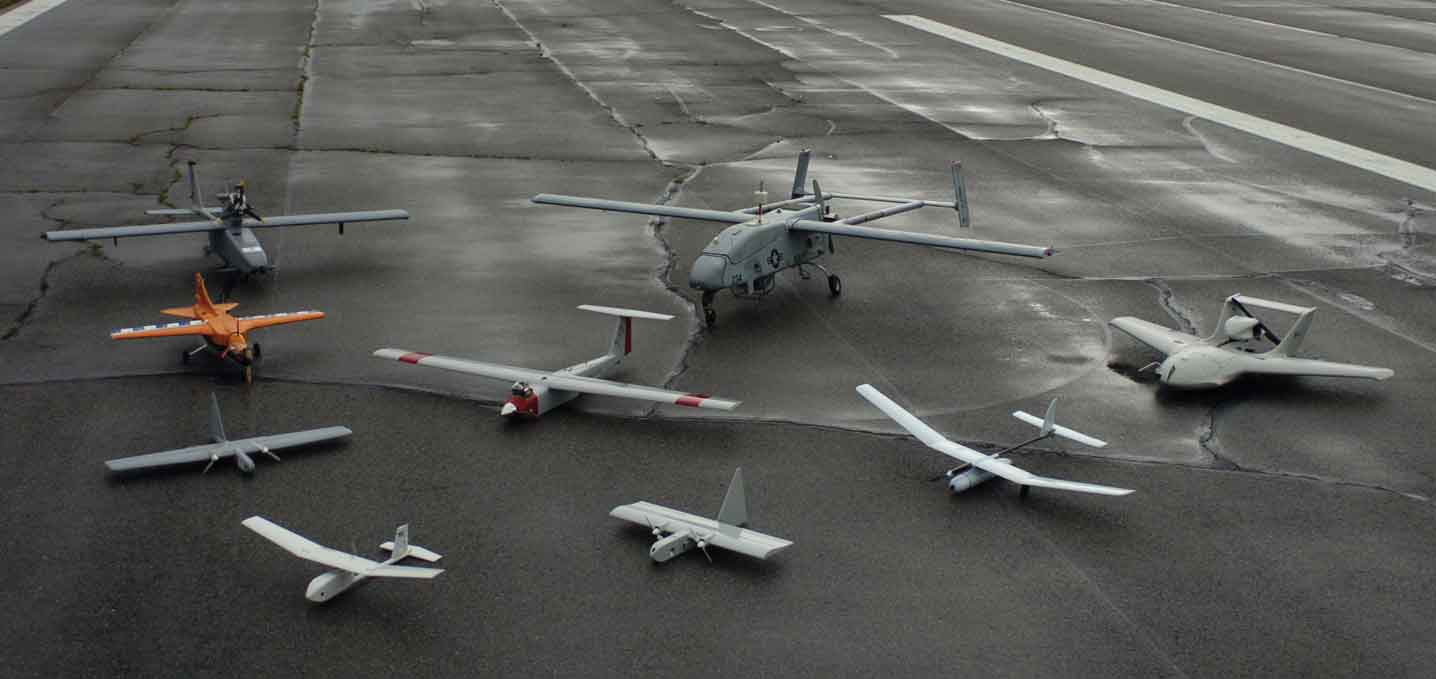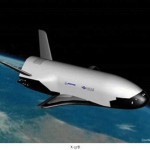
Various Unmanned Aerial Vehicles. Pictured are (front to back, left to right) RQ-11A Raven, Evolution, Dragon Eye, NASA FLIC, Arcturus T-15, Skylark, Tern, RQ-2B Pioneer, and Neptune.
Reports of Unmanned Aerial Vehicles (UAVs) being used for private and commercial use are a regular feature in the media. Does it mean that there is going to be sudden surge of UAVs flying in the Indian skies trailing advertising banners, delivering pizza or monitoring traffic? This is highly unlikely considering that unregulated use of UAVs for private and commercial use in civil airspace will result in chaos and accidents. In 1944, Clarence Johnson, the legendary founder of Lockheed’s Skunk Works and the designer of the SR-71 and U-2 reconnaissance aircraft, predicted that the future of military aviation would belong to the UAV. It appears that the prediction is slowly but surely coming true; now the market for civil and commercial applications of UAVs is poised for spectacular growth.
The last 25 years have seen the emergence of UAVs as ubiquitous weapon systems around the world…
Reports of Unmanned Aerial Vehicles (UAVs) being used for private and commercial use are a regular feature in the media. Does it mean that there is going to be sudden surge of UAVs flying in the Indian skies trailing advertising banners, delivering pizza or monitoring traffic? This is highly unlikely considering that unregulated use of UAVs for private and commercial use in civil airspace will result in chaos and accidents.
In 1944, Clarence Johnson, the legendary founder of Lockheed’s Skunk Works and the designer of the SR-71 and U-2 reconnaissance aircraft, predicted that the future of military aviation would belong to the UAV. It appears that the prediction is slowly but surely coming true; now the market for civil and commercial applications of UAVs is poised for spectacular growth.
Emergence of UAVs
The last 25 years have seen the emergence of UAVs as ubiquitous weapon systems around the world. In the 1990s, the Predator UAV was used in Bosnia and Kosovo to electronically monitor the battlefield. Weaponisation of the UAV was a logical progression and it was only a matter of time before it was used as an unobtrusive weapon of destruction. In September 2011, the New York Times reported that a Hellfire missile fired from a Predator launched from a secret CIA base in Saudi Arabia, killed Anwar Al Awlaki, an American-born Yemeni terrorist who had been placed on the CIA’s list for elimination. This was a watershed in modern military warfare wherein technology was employed to neutralise the enemy without putting own combatants in harm’s way.
Drone operations in Pakistan, Afghanistan and Yemen have drawn international criticism but more importantly, have put the civilian applications of UAVs in the shade away from public attention. This is not to say that there has been a slowdown in the use of UAVs for civilian roles but the adverse publicity has coloured civilian perceptions of privacy, personal freedom and safety while using UAVs for non-military roles.
Many government agencies that are not constrained by costs, as the civilian world is, use UAVs…
Military applications have driven the design and development of UAVs over the last four decades and there was very little attention to their use for civilian and commercial use. However, the focus is shifting and of late, there have been a number of studies worldwide to examine the use of UAVs for civilian applications. It is projected that the full range of capability currently available on military UAVs will be ready for civilian use within the next decade.
Military UAVs also referred to as Unmanned Aerial Systems (UAS), come in a wide variety of sizes and payload capability. The largest military UAS is bigger than a Boeing 737 and the smallest is a mere hand-held gadget. The term “UAS” drives home the relevance of the systems necessary for the operation of the unmanned aircraft and includes four elements:
- Unmanned aircraft.
- Control system or the ground station.
- Control-link or data-link.
- Other support equipment and personnel.
Immaterial of the size, payload or mission of the UAS, it cannot operate without all these elements working in harmony. Larger the range and endurance of the unmanned aircraft, greater the complexity of the data-link, the control station and the support equipment.
The push for civilian applications of UAVs could create a market worth $400 billion over the next ten years…
Civilian Application of UAVs
A recent study supported by the British Government and some of the leading aerospace companies in the UK has projected that the push for civilian applications of UAVs could create a market worth $400 billion over the next ten years. The consortium behind the programme sees potential use of drones for many roles currently undertaken by manned aircraft particularly for those that are “dirty, dull and dangerous” like search and rescue, inspection of oil pipelines and crop spraying. These roles are strenuous for the pilot and at times involve flying in treacherous conditions.
Civilian UAVs are currently in use or under consideration around the world for use in diverse environments or in high-risk roles such as:
- Wildfire detection and management
- Pollution monitoring
- Event security, policing and traffic management
- Disaster relief
- Fisheries management
- Pipeline monitoring and oil and gas security
- Meteorology – storm tracking
- Remote aerial mapping
- Power transmission line survey and inspection and checking of wind turbine blades
- Aerial photography
- Advertising and promotions
- Atmospheric research, oceanography, geophysical research
The list is endless and can include other applications such as checking safety of mines, monitoring of construction sites and inspection of bridges, railway lines, environmental inspection of nuclear, biological or chemical disaster areas. They are already being used in such diverse fields as agriculture and film making.
The impediments to civilian use of UAVs are many and include civil safety and environmental certification…
Employment of a plane or a helicopter is not cost-effective for a number of these tasks but presently it is the only choice. The availability of civilian UAVs provides a viable option. The scope for the commercial use of UAVs, therefore, is vast and the applications are limited only by the imagination of the operator. But there are impediments to overcome before these concepts are translated into reality.
The military views the UAV as a viable weapon system if it meets its operational tasks without endangering own combatants. Many government agencies that are not constrained by costs, as the civilian world is, use UAVs. However, the real challenge is to get the corporate world driven by the financial bottom lines to jump into this regime. Civilian use of UAVs is judged by the cost-benefits of using UAVs in lieu of piloted aircraft and businesses are unlikely to embrace this technology unless they find it financially viable. The cost per hour of UAV operation has to be less than that for a piloted aircraft.
The cost per hour of using an UAV is misleading because it merely addresses the cost of flying the vehicle and non-recurring costs must be factored in to arrive at an accurate assessment of the total cost of using UAVs for civilian applications. Some of these overhead expenses are driven by:
• Payload Integration
The UAV is only as effective as its payload and at times the payload has to be changed to meet the requirements of the user and this could involve modifications to the UAV which are very expensive.
The use of drones in war zones has been beset with accidents and issues of accountability…
• Transporting the UAV
The UAV may need to be transported from its home base to the area of interest. Depending on the UAV and its access to the national airspace, it may either be flown there or transported by air or surface transport. This cost of transportation has to be added to the mission cost.
• Support Staff Movement
All UAVs need support staff for their operation and some missions would need the support staff to move to different parts of the country or the world. This staff includes technicians for UAV setup, operation and maintenance, ground operators, payload specialists and users connected with the mission requirements who are all needed at site thus driving the costs upwards.
• Acquisition Costs
Civilian users of UAV technology are unlikely to acquire the vehicle as this will push the cost unless they have a year round plan to utilise the flight time. Most civilian users will contract operators for the use of the UAV and the cost per hour will take into account all non-recurring and recurring costs.
The recurring costs are those proportional to the flying hours and include the direct cost of fuel, routine maintenance and insurance. One major recurring expense is the cost of communications and depending on the complexity of the mission, location and range of operations the bandwidth requirements. These enhance the cost of the mission.





You are right. UAV is going to create security problem. The UAV used for commercial purpose is very easy to manufacture. UAV kits are available in the market costing $ 60 to $ 900. These Quad-copter’s can be identified easily. But it is very difficult to identify the man made birds and insects developed by USA army and used for spying.